Journal list menu
Export Citations
Download PDFs
Issue Information
Editor's Choice
EDITORIALS
Essentials for a successful registry: valid data, the right questions and timely execution
- Pages: 805-806
- First Published: 15 October 2018
Linked Articles: Gerbens et al. Br J Dermatol 2018; doi: 10.1111/bjd.16714. Garcia-Doval et al. Br J Dermatol 2018; 179:863–871. Grinich et al. Br J Dermatol 2018; 179:540–541.
Can antibiotics be harmful in atopic dermatitis?
- Pages: 807-808
- First Published: 15 October 2018
Linked Article: Harkins et al. Br J Dermatol 2018; 179:951–958.
The good, the bad and the malignant
- Pages: 809-810
- First Published: 15 October 2018
Linked Article: Garcia-Doval et al. Br J Dermatol 2018; 179:863–871.
Ixekizumab in genital psoriasis
- Pages: 811-812
- First Published: 15 October 2018
Linked Article: Ryan et al. Br J Dermatol 2018; 179:844–852.
Generating new evidence for old medications: the TREAT trial in paediatric atopic dermatitis
- Pages: 813-814
- First Published: 15 October 2018
Linked Article: Irvine et al. Br J Dermatol 2018; doi: 10.1111/bjd.16717.
COMMENTARIES
Long-term safety data for tofacitinib, an oral Janus kinase inhibitor, for the treatment for psoriasis
- Pages: 815-816
- First Published: 15 October 2018
Linked Article: Valenzuela et al. Br J Dermatol 2018; 179:853–862.
Is the Oral Disease Severity Score going to be useful for dermatologists when assessing pemphigus?
- Pages: 816-817
- First Published: 15 October 2018
Linked Article: Ormond et al. Br J Dermatol 2018; 179:872–881.
Problems hidden in plain sight
- Pages: 817-818
- First Published: 15 October 2018
Linked Article: Orlowska et al. Br J Dermatol 2018; 179:882–888.
What's new about the mechanism of methotrexate action in psoriasis?
- Pages: 818-819
- First Published: 15 October 2018
Linked Article: Yan et al. Br J Dermatol 2018; 179:896–905.
The utility of understanding atrophic acne scar formation for prevention and treatment
- Page: 819
- First Published: 15 October 2018
Linked Article: Carlavan et al. Br J Dermatol 2018; 179:906–917.
Relationships between clinical data and autoantibodies in bullous pemphigoid
- Pages: 820-821
- First Published: 15 October 2018
Linked Article: Holtsche et al. Br J Dermatol 2018; 179:918–924.
Revealing the mysteries of X-linked recessive ichthyosis
- Pages: 821-822
- First Published: 15 October 2018
Linked Article: Rodrigo-Nicolás et al. Br J Dermatol 2018; 179:933–939.
Assessing benefits and risks of holiday sun exposure in children
- Pages: 822-823
- First Published: 15 October 2018
Linked Article: Narbutt et al. Br J Dermatol 2018; 179:940–950.
A promising new treatment for SAPHO syndrome that deserves further studies
- Page: 823
- First Published: 15 October 2018
Linked Article: Adamo et al. Br J Dermatol 2018; 179:959–962.
Review
REVIEW ARTICLE
The new 8th edition of TNM staging and its implications for skin cancer: a review by the British Association of Dermatologists and the Royal College of Pathologists, U.K.
- Pages: 824-828
- First Published: 19 June 2018
What's already known about this topic?
- Knowledge of cancer stage is essential for optimal patient management.
- Cancer stage includes tumour characteristics, regional extension to lymph node(s) and the presence of any distant metastasis (termed TNM stage or stage group).
- TNM7, published in 2010, formed the basis of the professional datasets to handle and report skin cancer specimens, published online by the Royal College of Pathologists (www.rcpath.org).
What does this study add?
- TNM8 displays significant changes for skin cancer staging.
- Clinicians must state the maximum clinical dimension of every potential invasive skin cancer and whether involved lymph nodes are clinically detectable or occult in Merkel cell carcinoma and melanoma.
- Anatomical site and tumour differentiation no longer influence squamous cell carcinoma staging.
- Mitotic index does not influence pT in melanoma, but 0·8-mm Breslow thickness is a new criterion for the subdivision. pT1bN0M0 is now stage 1A.
Plain language summary available online
Original articles
CLINICAL TRIAL
A randomized split-scalp study comparing calcipotriol-assisted methyl aminolaevulinate photodynamic therapy (MAL-PDT) with conventional MAL-PDT for the treatment of actinic keratosis
- Pages: 829-835
- First Published: 24 February 2018
What's already known about this topic?
- Topical vitamin D pretreatment enhances methyl aminolaevulinate (MAL)-induced protoporphyrin IX (PpIX) in hairless mice.
- Topical vitamin D prior to aminolaevulinic acid photodynamic therapy (PDT) enhances treatment efficacy of nonmelanoma skin cancers in mouse skin models.
What does this study add?
- In human skin, calcipotriol (CAL)-assisted MAL-PDT proved to be superior to MAL-PDT alone and was well tolerated.
- Topical preconditioning of actinic keratoses with CAL-assisted MAL induced PpIX formation to a greater extent compared with the side that was not pretreated.
Plain language summary available online
A multicentre, open, investigator-initiated phase IV clinical trial to evaluate the efficacy and safety of ingenol mebutate gel, 0·015% on the face and scalp, and 0·05% on the trunk and extremities, in Korean patients with actinic keratosis (PERFECT)
- Pages: 836-843
- First Published: 20 January 2018
What's already known about this topic?
- Ingenol mebutate gel is used to treat actinic keratosis (AK).
- No clinical study has been conducted to date to investigate the efficacy, local skin responses, cosmetic outcomes, quality of life or other safety issues in Asian populations.
What does this study add?
- Ingenol mebutate gel was more effective and showed higher local skin responses in treating AK in Korean patients, compared with the previous studies.
- Ingenol mebutate is an effective treatment of AK in Asians, with tolerable safety profiles.
Efficacy and safety of ixekizumab in a randomized, double-blinded, placebo-controlled phase IIIb study of patients with moderate-to-severe genital psoriasis
- Pages: 844-852
- First Published: 10 May 2018
What's already known about this topic?
- Genital psoriasis is a common and burdensome form of plaque psoriasis, but there are few controlled studies of effective therapies.
What does this study add?
- Ixekizumab significantly improved the severity of genital psoriasis and associated disease characteristics.
- Ixekizumab may be appropriate for treatment of moderate-to-severe genital psoriasis, even in patients with limited body surface involvement.
Linked Editorial: Becher and Burden. Br J Dermatol 2018; 179:811–812.
Plain language summary available online
Tofacitinib in patients with moderate-to-severe chronic plaque psoriasis: long-term safety and efficacy in an open-label extension study
- Pages: 853-862
- First Published: 21 May 2018
What's already known about this topic?
- Tofacitinib is an oral Janus kinase inhibitor. The efficacy and safety of tofacitinib 5 mg and 10 mg twice daily has been reported in phase II and phase III trials in patients with moderate-to-severe plaque psoriasis.
- The management of patients with plaque psoriasis requires long-term maintenance treatment.
What does this study add?
- Final safety and efficacy data from this long-term extension study indicate that tofacitinib has a stable safety profile up to 66 months, which is consistent with that observed in previous tofacitinib studies.
- Improvements in efficacy end points and patient-reported outcomes are sustained up to 54 months.
Linked Comment: Lloyd-Lavery. Br J Dermatol 2018; 179:815–816.
EPIDEMIOLOGY
Cumulative exposure to biological therapy and risk of cancer in patients with psoriasis: a meta-analysis of Psonet studies from Israel, Italy, Spain, the U.K. and Republic of Ireland
- Pages: 863-871
- First Published: 03 May 2018
What's already known about this topic?
- Systemic therapies, including biologics, are widely prescribed for patients with moderate-to-severe psoriasis.
- As a result of the immunomodulatory mechanism of biological therapies for psoriasis it is hypothesized that long-term exposure to them may increase the risk of developing cancer.
What does this study add?
- This study suggests that, in current clinical practice, the treatment of patients with psoriasis with biologics is not associated with an increased risk of cancer in the medium term, after a few years of use and latency.
- Given the heterogeneity of the data sources and methodological limitations, it remains unclear if use of biologics may be associated with an increased (albeit small) risk of certain cancer subtypes.
Linked Editorial: Egeberg. Br J Dermatol 2018; 179:809–810.
Plain language summary available online
QUALITATIVE AND OUTCOMES RESEARCH
An Oral Disease Severity Score validated for use in oral pemphigus vulgaris
- Pages: 872-881
- First Published: 03 January 2018
What's already known about this topic?
- Current pemphigus vulgaris (PV) disease activity indices include the recently validated Pemphigus Disease Area Index (PDAI) and the Autoimmune Bullous Skin Disorder Intensity Score.
- The Oral Disease Severity Score (ODSS) has been demonstrated to have good inter- and intraobserver reliability in both lichen planus (LP) and mucous membrane pemphigoid (MMP).
What does this study add?
- The ODSS is shown to be a thorough and sensitive, yet quick assessment tool for oral involvement in PV.
- Its versatility for use additionally in MMP and LP is an added advantage over previously validated methods.
What are the clinical implications of this work?
- We propose that the ODSS would be a useful supplement for future multicentre studies, as well as for recording sequential disease activity in the clinic.
Linked Comment: Murrell et al. Br J Dermatol 2018; 179:816–817.
Plain language summary available online
‘It's a traumatic illness, traumatic to witness’: a qualitative study of the experiences of bereaved family caregivers of patients with cutaneous T-cell lymphoma
- Pages: 882-888
- First Published: 16 February 2018
What's already known about this topic?
- Cutaneous T-cell lymphoma (CTCL) is a rare cancer with multiple negative impacts on the quality of life of patients and their carers, particularly in advanced disease.
- Care of extensive skin lesions in advanced CTCL is complex and time-consuming.
- A systematic review of the literature on CTCL revealed no exploration of the needs or experiences of family carers.
What does this study add?
- Care for patients with advanced CTCL is complex and challenging, and family caregivers can adopt quasi-professional roles.
- Even in advanced CTCL and despite multiple hospital admissions, family caregivers may not expect their relative's death and experience highly variable bereavement support.
- Healthcare providers should consider the support needs of family caregivers as well as those of patients with advanced CTCL and support should be provided during the course of the disease and into bereavement, whatever the place of care and death.
What are the clinical implications of the work?
- Healthcare providers need to take a flexible, person-centred approach to care, rather than relying on existing organizational systems to meet the needs of complex patients with the extensive skin breakdown present in advanced CTCL.
- CTCL raises specific challenges for caregivers given its initially benign appearance and rarity – adapting to the worsening symptoms and prognosis may require specific support for family caregivers.
Linked Comment: Mitchell. Br J Dermatol 2018; 179:817–818.
Plain language summary available online
TRANSLATIONAL RESEARCH
The efficacy of a nested polymerase chain reaction in detecting the cytochrome c oxidase subunit 1 gene of Sarcoptes scabiei var. hominis for diagnosing scabies
- Pages: 889-895
- First Published: 06 April 2018
What's already known about this topic?
- Previous studies have demonstrated the usefulness of conventional polymerase chain reaction (PCR) in diagnosing scabies but the positive diagnosis rate was too low to obtain satisfactory results.
- Research comparing PCR for scabies diagnosis against microscopy detection did not include dermoscopy; therefore, it is possible that there were high false-negative rates by microscopy and the effectiveness of a PCR assay was overstated.
What does this study add?
- The detection rate of scabies by nested PCR in patients who were microscopy negative (26%, nine of 35 samples) was higher than by conventional PCR (14%, 12 of 83 samples).
- Even though false-negatives were minimized in this study owing to the inclusion of dermoscopy, the microscopy sensitivity was 75·7% (95% confidence interval 58·8–88·2), which was significantly inferior to that of the cox1 nested PCR (P = 0·004).
What is the translational message?
- Nested PCR can be successfully used as an alternative method for diagnosing suspected scabies in patients.
- Infection control measures and treatments can be initiated before significant transmission occurs, minimizing the risk of outbreaks.
Plain language summary available online
Methotrexate restores the function of peripheral blood regulatory T cells in psoriasis vulgaris via the CD73/AMPK/mTOR pathway
- Pages: 896-905
- First Published: 23 March 2018
What's already known about this topic?
- CD73+ regulatory T cells (Tregs) were markedly reduced in patients with psoriasis vulgaris compared with healthy controls.
- Methotrexate (MTX) is widely used to treat psoriasis and has also been reported to upregulate the expression of CD73 in melanoma.
What does this study add?
- We investigated the effect and mechanism of MTX on Treg function and its relationship to the CD73/AMPK/mTOR pathway in psoriasis therapy.
What is the translational message?
- These findings may partly explain the mechanism by which MTX treats psoriasis.
Linked Comment: Chen. Br J Dermatol 2018; 179:818–819.
Plain language summary available online
Atrophic scar formation in patients with acne involves long-acting immune responses with plasma cells and alteration of sebaceous glands
- Pages: 906-917
- First Published: 16 April 2018
What's already known about this topic?
- Early activation of innate immunity was observed in clinically normal skin of patients with acne prone to atrophic scarring.
- Inflammation is stronger and lasts longer in 1-week-old papules in patients prone to scarring.
What does this study add?
- The inflammatory response in papules of scar-prone (SP) patients with acne can last > 3 weeks.
- Plasma cells are specifically involved in the immune response of evolved-lesions in SP patients only.
- Downregulation of sebaceous gland markers associated with the long-term inflammatory response in SP patients suggests destruction of sebaceous glands.
What is the translational message?
- Inflammatory immune processes persist for at least 3 weeks in the lesions of SP patients with acne. New early and sustained treatment regimens preventing or at least reducing the duration of inflammatory processes in SP patients with acne are required.
Linked Comment: Wang and Saedi. Br J Dermatol 2018; 179:819.
MEDICAL DERMATOLOGY
Prospective study in bullous pemphigoid: association of high serum anti-BP180 IgG levels with increased mortality and reduced Karnofsky score
- Pages: 918-924
- First Published: 01 April 2018
What's already known about this topic?
- Serum levels of immunoglobulin (Ig)G autoantibodies against BP180 correlate with disease activity in bullous pemphigoid (BP).
- Reports about the correlation of serum anti-BP180 IgE with disease severity are inconclusive.
- Karnofsky score is a predictor of death in BP but to date has not been shown to be related to serum autoantibody levels.
What does this study add?
- High serum anti-BP180 IgG levels are associated with an increased mortality in BP.
- Patients with BP with a lower Karnofsky score show higher serum levels of anti-BP180 and anti-BP230 IgG.
- High levels of total serum IgE appear to be related to a lower number of treatment-related adverse events.
- Patients with BP with high anti-BP180 IgG may be at risk of fatal outcomes, while in those with high total IgE, fewer adverse events can be expected.
Linked Comment: Hashimoto and Tsuruta. Br J Dermatol 2018; 179:820–821.
Plain language summary available online
PAEDIATRIC DERMATOLOGY
Paediatric mastocytosis: long-term follow-up of 53 patients with whole sequencing of KIT. A prospective study
- Pages: 925-932
- First Published: 22 May 2018
What's already known about this topic?
- The clinical and genetic features and outcomes of mastocytosis differ between the adult and paediatric forms.
- Paediatric mastocytosis is also a clonal disease.
- Spontaneous regression occurs in the majority of cases and no predictive factors have been identified.
What does this study add?
- This prospective study of 53 patients shows that KIT mutation is not a predictor of evolution. However, characteristics such as age at disease onset could be predictors.
- Paediatric mastocytosis evolution is not systematically regressive, and adolescents can experience only partial regression or aggravation, including both cutaneous and mast cell mediator-related symptoms.
- A long-term follow-up study of paediatric patients with mastocytosis is needed.
Plain language summary available online
GENERAL DERMATOLOGY
Evidence of the high prevalence of neurological disorders in nonsyndromic X-linked recessive ichthyosis: a retrospective case series
- Pages: 933-939
- First Published: 14 June 2018
What's already known about this topic?
- Nonsyndromic X-linked recessive ichthyosis is a relatively common type of ichthyosis.
- Prior studies found a high prevalence of cryptorchidism and attention deficit hyperactivity disorder (ADHD).
What does this study add?
- We identified a high prevalence of epilepsy (13%), confirmed a high frequency of ADHD (30%) and found a 10% prevalence of orchiopexy.
- We also quantified other common findings such palmoplantar hyperlinearity (almost always absent) and pruritus (present in 60% of patients).
Linked Comment: Traupe. Br J Dermatol 2018; 179:821–822.
Plain language summary available online
Children sustain high levels of skin DNA photodamage, with a modest increase of serum 25-hydroxyvitamin D3, after a summer holiday in Northern Europe
- Pages: 940-950
- First Published: 24 April 2018
What's already known about this topic?
- Tenerife and skiing holiday studies in adults have shown an ultraviolet (UV)B-dependent increase in 25-hydroxyvitamin D3 [25(OH)D3] and potentially mutagenic cyclobutane pyrimidine dimers (CPD) that may initiate skin cancer.
- Childhood solar UV radiation exposure increases the risk of skin cancer in adulthood, but no study has assessed the risks and benefits of solar UV radiation in children on holiday.
What does this study add?
- Relatively low daily UV radiation doses in children at a Baltic Sea summer camp resulted in a modest but significant improvement in 25(OH)D3 (24%) but a very much greater increase in CPD (1162%).
- The children had the same level of CPD as adults who had higher UV radiation doses over a shorter holiday in Tenerife.
- These results stress the importance of rigorous photoprotection in the young.
Linked Comment: Webb. Br J Dermatol 2018; 179:822–823.
The widespread use of topical antimicrobials enriches for resistance in Staphylococcus aureus isolated from patients with atopic dermatitis
- Pages: 951-958
- First Published: 05 May 2018
What's already known about this topic?
- Staphylococcus aureus frequently colonizes individuals with atopic dermatitis (AD), with increasing disease severity correlating with greater bacterial load of the organism.
- Antimicrobial therapies are routinely used in AD for management and prevention of disease flares.
What does this study add?
- Staphylococcus aureus isolates from children with AD differ in their antimicrobial resistance profiles from those in healthy, nonatopic nasally colonized children.
- Fusidic acid resistance is significantly more prevalent in cases of AD, and arises through distinct genetic mechanisms when compared with healthy controls.
- Carriage of plasmid-derived genetic determinants associated with antiseptic resistance also clearly differentiated S. aureus from cases of AD and controls.
Linked Editorial: Leung. Br J Dermatol 2018; 179:807–808.
Plain language summary available online
Case report
THERAPY
Successful treatment of SAPHO syndrome with apremilast
- Pages: 959-962
- First Published: 16 October 2017
What's already known about this topic?
- SAPHO (synovitis, acne, pustulosis, hyperostosis and osteitis) syndrome is a disease of unknown cause but genetically several similarities to autoinflammatory diseases have been found.
- Clinically, dermatological and osteoarticular manifestations resemble signs of neutrophil activation.
- Usual treatments include nonsteroidal anti-inflammatory drugs and corticosteroids but treatment with tumour necrosis factor (TNF)-α or interleukin (IL)-1 antagonists have also been previously reported.
What does this study add?
- Given that TNF-α, IL-23 and IL-17 together with activated neutrophils are involved in the pathogenesis of SAPHO syndrome, blocking of these cytokines is a potential strategy in treatment-refractory cases.
- The use of specific cytokine-directed antibodies such as ustekinumab or secukinumab or pan-cytokine inhibition with apremilast provides further therapeutic options in the management of this rare condition.
Linked Comment: Firinu. Br J Dermatol 2018; 179:823.
Correspondence
RESEARCH LETTERS
SunSmart schools: a New Zealand skin cancer primary prevention intervention blueprint for primary school settings
- Pages: 963-964
- First Published: 14 April 2018
Skin microbiome changes in patients with interdigital tinea pedis
- Pages: 965-968
- First Published: 28 April 2018
Perinevoid alopecia: a case report and literature review
- Pages: 969-970
- First Published: 28 April 2018
Risk of skin cancer in people with vitiligo: a systematic review and meta-analysis
- Pages: 971-972
- First Published: 28 April 2018
Clinical, dermoscopic, histological and molecular analysis of BAP1-inactivated melanocytic naevus/tumour in two familial cases of BAP1 syndrome
- Pages: 973-975
- First Published: 13 May 2018
Effective sirolimus treatment for refractory spindle cell haemangioma
- Pages: 976-977
- First Published: 11 May 2018
Polysensitivity in delayed cutaneous adverse drug reactions to macrolides, clindamycin and pristinamycin: clinical history and patch testing
- Pages: 978-979
- First Published: 10 May 2018
Failure of rituximab in refractory erosive lichen planus
- Pages: 980-981
- First Published: 28 April 2018
Correlation of psoriasis activity with socioeconomic status: cross-sectional analysis of patients enrolled in the Psoriasis Longitudinal Assessment and Registry (PSOLAR)
- Pages: 984-986
- First Published: 10 May 2018
Elevated total serum IgE in vitiligo might be protective for other autoimmune diseases
- Pages: 987-988
- First Published: 28 April 2018
Assessment of treatment-seeking behaviour in patients with psoriasis
- Pages: 989-990
- First Published: 14 May 2018
Is melanoma mortality declining in Spain? Analysis of trends from 1975 to 2016
- Pages: 991-992
- First Published: 14 May 2018
Pembrolizumab-associated mucous membrane pemphigoid in a patient with Merkel cell carcinoma
- Pages: 993-994
- First Published: 14 May 2018
Joint recommendations for retinal screening in long-term users of hydroxychloroquine and chloroquine in the United Kingdom, 2018
- Pages: 995-996
- First Published: 16 May 2018
Melanoma diagnosis during periodic surveillance of patients with multiple atypical naevi
- Pages: 997-998
- First Published: 28 April 2018
Prospective evaluation of the frequency of genital lichen sclerosus in 79 patients with systemic sclerosis
- Pages: 999-1000
- First Published: 21 June 2018
Identification of a recurrent mutation in ATP2C1 demonstrates that papular acantholytic dyskeratosis and Hailey–Hailey disease are allelic disorders
- Pages: 1001-1002
- First Published: 26 June 2018
Relationship and probabilistic stratification of Eczema Area and Severity Index and objective Scoring Atopic Dermatitis severity scores for atopic dermatitis
- Pages: 1003-1005
- First Published: 26 June 2018
The role of parenting experiences, rather than age of onset or presence of the skin condition, in the development of early maladaptive schemas in a community sample of patients with atopic dermatitis
- Pages: 1006-1008
- First Published: 26 June 2018
A large epidemiological study of erythema multiforme in France, with emphasis on treatment choices
- Pages: 1009-1011
- First Published: 29 June 2018
LETTERS TO THE EDITOR
Is the Oral Disease Severity Score going to be useful for dermatologists when assessing pemphigus? Reply from the authors
- Pages: 1012-1013
- First Published: 15 October 2018
Beyond Bitcoin: potential applications of blockchain technology in dermatology
- Pages: 1013-1014
- First Published: 26 June 2018
Cardiovascular disease and atopic dermatitis: epidemiological strengths and limitations
- Pages: 1014-1015
- First Published: 03 July 2018
Linked Articles: Drucker and Flohr. Br J Dermatol 2018; doi.10.1111/bjd.16891
Mepacrine-induced interstitial lung disease in discoid lupus erythematosus?
- Page: 1015
- First Published: 19 July 2018
IMAGE CORRESPONDENCE
Cover Image: Trichophyton rubrum penetration of horny cells in dermatophytosis
- Page: 1016
- First Published: 15 October 2018
News and Notices
IMAGE CORRESPONDENCE
Image Gallery: An unusual presentation of pseudoxanthomatous mastocytosis
- Page: e165
- First Published: 15 October 2018
Image Gallery: 308-nm ultraviolet B excimer laser treatment for cutaneous B-cell lymphoma nodular lesions on the face
- Page: e166
- First Published: 15 October 2018
Image Gallery: Granulomatous dermatitis due to infection with the chlorophyllic green alga Desmodesmus
- Page: e167
- First Published: 15 October 2018
Image Gallery: Bilateral juvenile temporal arteritis
- Page: e168
- First Published: 15 October 2018
PLAIN LANGUAGE SUMMARIES
An Oral Disease Severity Score for pemphigus vulgaris
- Page: e169
- First Published: 15 October 2018
Linked Article: Ormond et al. Br J Dermatol 2018; 179:872–881
Experiences of bereaved family caregivers of patients with CTCL
- Page: e170
- First Published: 15 October 2018
Linked Article: Orlowska et al. Br J Dermatol 2018; 179:882–888
Calcipotriol-assisted vs. conventional MAL-PDT in actinic keratosis
- Page: e171
- First Published: 15 October 2018
Linked Article: Torezan et al. Br J Dermatol 2018; 179:829–835
BP: serum anti-BP180 IgG levels, mortality and Karnofsky score
- Page: e172
- First Published: 15 October 2018
Linked Article: Holtsche et al. Br J Dermatol 2018; 179:918–924
Nested PCR for diagnosing scabies infestation
- Page: e173
- First Published: 15 October 2018
Linked Article: Hahm et al. Br J Dermatol 2018; 179:889–895
Methotrexate activated Tregs via the CD73/AMPK/mTOR pathway
- Page: e174
- First Published: 15 October 2018
Linked Article: Yan et al. Br J Dermatol 2018; 179:896–905
Biological therapy for psoriasis and risk of cancer
- Page: e175
- First Published: 15 October 2018
Linked Article: Garcia-Doval et al. Br J Dermatol 2018; 179:863–871
Topical antimicrobial resistance in S. aureus from patients with AD
- Page: e176
- First Published: 15 October 2018
Linked Article: Harkins et al. Br J Dermatol 2018; 179:951–958
Ixekizumab efficacy and safety in moderate-to-severe genital psoriasis
- Page: e177
- First Published: 15 October 2018
Linked Article: Ryan et al. Br J Dermatol 2018; 179:844–852
Paediatric mastocytosis: a 12-year follow-up cohort
- Page: e178
- First Published: 15 October 2018
Linked Article: Meni et al. Br J Dermatol 2018; 179:925–932
New 8th edition of TNM staging and implications for skin cancer
- Page: e179
- First Published: 15 October 2018
Linked Article: Keohane et al. Br J Dermatol 2018; 179:824–828
Recessive XLI: high prevalence of neurological disorders
- Page: e180
- First Published: 15 October 2018
Linked Article: Rodrigo-Nicolás et al. Br J Dermatol 2018; 179:933–939
寻常天疱疮口腔疾病严重程度评分
- Page: e181
- First Published: 15 October 2018
Linked Article: Ormond et al. Br J Dermatol 2018; 179:872–881
失去亲人的 CTCL 患者的家庭照护者经历
- Page: e182
- First Published: 15 October 2018
Linked Article: Orlowska et al. Br J Dermatol 2018; 179:882–888
卡泊三醇辅助与常规 MAL-PDT 治疗光化性角化病的比较
- Page: e183
- First Published: 15 October 2018
Linked Article: Torezan et al. Br J Dermatol 2018; 179:829–835
BP:血清抗 BP180 IgG 水平、死亡率和卡式评分
- Page: e184
- First Published: 15 October 2018
Linked Article: Holtsche et al. Br J Dermatol 2018; 179:918–924
用于诊断疥疮感染的巢式 PCR
- Page: e185
- First Published: 15 October 2018
Linked Article: Hahm et al. Br J Dermatol 2018; 179:889–895
甲氨蝶呤通过 CD73/AMPK/mTOR 通路激活 Treg
- Page: e186
- First Published: 15 October 2018
Linked Article: Yan et al. Br J Dermatol 2018; 179:896–905
银屑病的生物治疗和癌症风险
- Page: e187
- First Published: 15 October 2018
Linked Article: Garcia-Doval et al. Br J Dermatol 2018; 179:863–871
来自 AD 患者的金黄色葡萄球菌的局部抗生素耐药性
- Page: e188
- First Published: 15 October 2018
Linked Article: Harkins et al. Br J Dermatol 2018; 179:951–958
伊赛珠单抗在中度至重度生殖器银屑病中的疗效和安全性
- Page: e189
- First Published: 15 October 2018
Linked Article: Ryan et al. Br J Dermatol 2018; 179:844–852
小儿肥大细胞增多症:一项为期 12 年的随访队列研究
- Page: e190
- First Published: 15 October 2018
Linked Article: Meni et al. Br J Dermatol 2018; 179:925–932
新的第 8 版皮肤癌 TNM 分期和影响
- Page: e191
- First Published: 15 October 2018
Linked Article: Keohane et al. Br J Dermatol 2018; 179:824–828
隐性 XLI: 神经系统疾病的高患病率
- Page: e192
- First Published: 15 October 2018
Linked Article: Rodrigo-Nicolás et al. Br J Dermatol 2018; 179:933–939




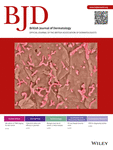

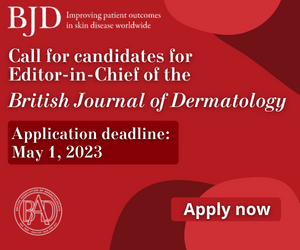
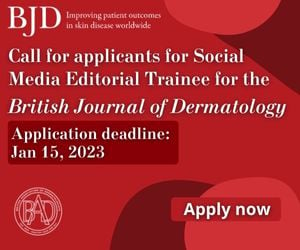

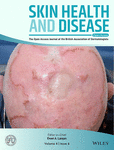
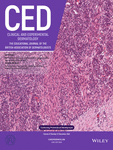
2690-442X.cover.png)